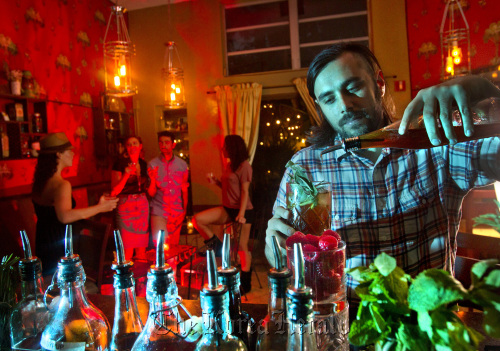Time to belly up to the bar for a martini or a Manhattan. Go ahead and splurge ― make it with Grey Goose or Crown Royal.
The economy may not have rebounded enough to justify a luxury car or exotic vacation, but the affordable luxury of a super-premium cocktail is back in vogue across the country. After a brief slowdown during the recession, when consumers cut back on drinking at bars and restaurants, the spirits industry is once again on the upswing.
U.S. spirits volume in 2011 rose 2.7 percent from the prior year, while sales grew 4 percent to $19.92 billion, according to the Distilled Spirits Council of the United States. Some of that growth has come from consumers shifting from beer to spirits, as market share for spirits rose to 33.6 percent while beer declined to 49.2 percent. Wine also gained share, growing to 17.1 percent.
And the biggest jumps have come from the super-premium brands, where sales volume jumped 8.9 percent during 2011.
“This is the classic pattern we see during a recovery,” said David Ozgo, senior vice president of Discus, the industry trade association. “In every recession we see a decline in volume growth and a shift to value brands. Post-recession, it’s all about a return to premiumization. People get the confidence to start trading up and spending a little more.”
 |
Co-Owner Elad Zvi mixes a high end cocktail on Feb. 6 at the Broken Shaker, a pop-up bar that just opened at the Indian Creek Hotel on Miami Beach, Florida. (Miami Herald/MCT) |
Helping to fuel that cocktail boom is a focus on innovation driven by the introduction of new products. The latest twist is adding new flavors to already popular brands.
That’s the idea behind introductions like Bacardi Oakheart, a spiced rum, and Jack Daniel’s Tennessee Honey whiskey.
“We do a lot of work looking for new cocktails and new ideas; Miami is a good laboratory for that,” said Robert Furniss-Roe, president of Bacardi U.S.A., which is based in Coral Gables, Fla. “You continue to see consumers wanting to look for touch points in the past.”
That’s why everything old is also new again. Classics like the Old-Fashioned and Negroni are showing up at hipster bars. And in honor of Bacardi’s 150th anniversary, the brand is promoting the historical significance behind traditional favorites like the Cuba Libre and daiquiri.
“They’re classics for a reason: because they survived the test of time,” said Tony Abou-Ganim, an industry leader known as the “modern mixologist.” “There will never be another original cocktail created again; it’s just twists on what came before. It’s the job of the bartender to expand people’s awareness and understanding of the cocktail segment.”
Bar Lab mixologists Gabriel Orta and Elad Zvi heeded the call with the Broken Shaker, a pop-up bar they opened last month at Miami Beach, Fla.’s Indian Creek Hotel.
“People are really embracing the cocktail: it’s a lost art,” Orta said. “They like the showmanship and the craft behind it. They really enjoy sitting and watching something fresh being made in front of their eyes.”
Even small gains in spirits-market share translates into significant dollars ― especially at a time when U.S. per capita consumption is relatively flat. The biggest surge in sales is coming from packaged or bottled cocktails, single malt scotch and vodka.
Industry experts attribute the increase to the popularity of cocktails among women and Generation Y, plus a desire by consumers to take what they’ve enjoyed at a bar and duplicate it at home.
“People get bored with just opening a bottle of wine or beer,” said Tom Pirko of BEVMARK, an industry consultancy. “Now they’re starting to experiment. They’re looking for new sensations. They’re just more interested in flavor.”
By Elaine Walker
(McClatchy Newspapers)
(MCT Information Services)








